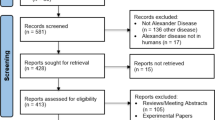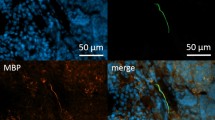Abstract
Alexander disease (AxD) is an astrogliopathy that primarily affects the white matter of the central nervous system (CNS). AxD is caused by mutations in a gene encoding GFAP (glial fibrillary acidic protein). The GFAP mutations in AxD have been reported to act in a gain-of-function manner partly because the identified mutations generate practically full-length GFAP. We found a novel nonsense mutation (c.1000 G>T, p.(Glu312Ter); also termed p.(E312*)) within a rod domain of GFAP in a 67-year-old Korean man with a history of memory impairment and leukoencephalopathy. This mutation, GFAP p.(E312*), removes part of the 2B rod domain and the whole tail domain from the GFAP. We characterized GFAP p.(E312*) using western blotting, in vitro assembly and sedimentation assay, and transient transfection of human adrenal cortex carcinoma SW13 (Vim+) cells with plasmids encoding GFAP p.(E312*). The GFAP p.(E312*) protein, either alone or in combination with wild-type GFAP, elicited self-aggregation. In addition, the assembled GFAP p.(E312*) aggregated into paracrystal-like structures, and GFAP p.(E312*) elicited more GFAP aggregation than wild-type GFAP in the human adrenal cortex carcinoma SW13 (Vim+) cells. Our findings are the first report, to the best of our knowledge, on this novel nonsense mutation of GFAP that is associated with AxD and paracrystal formation.
Similar content being viewed by others
Log in or create a free account to read this content
Gain free access to this article, as well as selected content from this journal and more on nature.com
or
Accession codes
References
Gorospe JR Alexander Diesease [online]. Available at http://www.ncbi.nlm.nih.gov/books/NBK1172/ . Accessed 21 Jan 2014.
Johnson AB, Brenner M : Alexander’s disease: clinical, pathologic, and genetic features. J Child Neurol 2003; 18: 625–632.
Messing A, Brenner M, Feany MB, Nedergaard M, Goldman JE : Alexander disease. J Neurosci 2012; 32: 5017–5023.
Parpura V, Haydon PG : Astrocytes in (Patho)Physiology of the Nervous System. New York: Springer, 2009.
Quinlan RA, Brenner M, Goldman JE, Messing A : GFAP and its role in Alexander disease. Exp Cell Res 2007; 313: 2077–2087.
Sawaishi Y : Review of Alexander disease: beyond the classical concept of leukodystrophy. Brain Dev 2009; 31: 493–498.
Verkhratsky A, Sofroniew MV, Messing A et al: Neurological diseases as primary gliopathies: a reassessment of neurocentrism. ASN Neuro 2012; 4: e00082.
Brenner M, Johnson AB, Boespflug-Tanguy O, Rodriguez D, Goldman JE, Messing A : Mutations in GFAP, encoding glial fibrillary acidic protein, are associated with Alexander disease. Nat Genet 2001; 27: 117–120.
Reeves SA, Helman LJ, Allison A, Israel MA : Molecular cloning and primary structure of human glial fibrillary acidic protein. Proc Natl Acad Sci USA 1989; 86: 5178–5182.
Middeldorp J, Hol EM : GFAP in health and disease. Prog Neurobiol 2011; 93: 421–443.
Messing A Alexander disease [online]. Available at http://www.waisman.wisc.edu/alexander-disease/ . Accessed 21 Jan 2014.
Mignot C, Boespflug-Tanguy O, Gelot A, Dautigny A, Pham-Dinh D, Rodriguez D : Alexander disease: putative mechanisms of an astrocytic encephalopathy. Cell Mol Life Sci 2004; 61: 369–385.
Prust M, Wang J, Morizono H et al: GFAP mutations, age at onset, and clinical subtypes in Alexander disease. Neurology 2011; 77: 1287–1294.
Ahn HJ, Chin J, Park A et al: Seoul Neuropsychological Screening Battery-dementia version (SNSB-D): a useful tool for assessing and monitoring cognitive impairments in dementia patients. J Korean Med Sci 2010; 25: 1071–1076.
Sambrook J, Russell DW : Molecular Cloning: A Laboratory Manual 3rd edn Cold Spring Harbor, NY: Cold Spring Harbor Laboratory Press, 2001.
Joutel A, Vahedi K, Corpechot C et al: Strong clustering and stereotyped nature of Notch3 mutations in CADASIL patients. Lancet 1997; 350: 1511–1515.
Der Perng M, Su M, Wen SF et al: The Alexander disease-causing glial fibrillary acidic protein mutant, R416W, accumulates into Rosenthal fibers by a pathway that involves filament aggregation and the association of alpha B-crystallin and HSP27. Am J Hum Genet 2006; 79: 197–213.
Nicholl ID, Quinlan RA : Chaperone activity of alpha-crystallins modulates intermediate filament assembly. EMBO J 1994; 13: 945–953.
Sandilands A, Prescott AR, Carter JM et al: Vimentin and CP49/filensin form distinct networks in the lens which are independently modulated during lens fibre cell differentiation. J Cell Sci 1995; 108 (Pt 4): 1397–1406.
Chabriat H, Joutel A, Dichgans M, Tournier-Lasserve E, Bousser MG : Cadasil. Lancet Neurol 2009; 8: 643–653.
Joutel A, Favrole P, Labauge P et al: Skin biopsy immunostaining with a Notch3 monoclonal antibody for CADASIL diagnosis. Lancet 2001; 358: 2049–2051.
Farina L, Pareyson D, Minati L et al: Can MR imaging diagnose adult-onset Alexander disease? AJNR Am J Neuroradiol 2008; 29: 1190–1196.
van der Knaap MS, Ramesh V, Schiffmann R et al: Alexander disease: ventricular garlands and abnormalities of the medulla and spinal cord. Neurology 2006; 66: 494–498.
Chen YS, Lim SC, Chen MH, Quinlan RA, Perng MD : Alexander disease causing mutations in the C-terminal domain of GFAP are deleterious both to assembly and network formation with the potential to both activate caspase 3 and decrease cell viability. Exp Cell Res 2011; 317: 2252–2266.
Quinlan RA, Moir RD, Stewart M : Expression in Escherichia coli of fragments of glial fibrillary acidic protein: characterization, assembly properties and paracrystal formation. J Cell Sci 1989; 93 (Pt 1): 71–83.
Aebi U, Cohn J, Buhle L, Gerace L : The nuclear lamina is a meshwork of intermediate-type filaments. Nature 1986; 323: 560–564.
Perng MD, Wen SF, Gibbon T et al: Glial fibrillary acidic protein filaments can tolerate the incorporation of assembly-compromised GFAP-delta, but with consequences for filament organization and alphaB-crystallin association. Mol Biol Cell 2008; 19: 4521–4533.
Flint D, Li R, Webster LS et al: Splice site, frameshift, and chimeric GFAP mutations in Alexander disease. Hum Mutat 2012; 33: 1141–1148.
Herrmann H, Haner M, Brettel M et al: Structure and assembly properties of the intermediate filament protein vimentin: the role of its head, rod and tail domains. J Mol Biol 1996; 264: 933–953.
Chen WJ, Liem RK : The endless story of the glial fibrillary acidic protein. J Cell Sci 1994; 107 (Pt 8): 2299–2311.
van der Knaap MS, Naidu S, Breiter SN et al: Alexander disease: diagnosis with MR imaging. AJNR Am J Neuroradiol 2001; 22: 541–552.
Balbi P, Seri M, Ceccherini I et al: Adult-onset Alexander disease: report on a family. J Neurol 2008; 255: 24–30.
Okamoto Y, Mitsuyama H, Jonosono M et al: Autosomal dominant palatal myoclonus and spinal cord atrophy. J Neurol Sci 2002; 195: 71–76.
Pareyson D, Fancellu R, Mariotti C et al: Adult-onset Alexander disease: a series of eleven unrelated cases with review of the literature. Brain 2008; 131: 2321–2331.
Wada Y, Yanagihara C, Nishimura Y, Namekawa M : Familial adult-onset Alexander disease with a novel mutation (D78N) in the glial fibrillary acidic protein gene with unusual bilateral basal ganglia involvement. J Neurol Sci 2013; 331: 161–164.
Safer D, Pepe FA : Axial packing in light meromyosin paracrystals. J Mol Biol 1980; 136: 343–358.
Cohen C, Szent-Gyorgyi AG, Kendrick-Jones J : Paramyosin and the filaments of molluscan ‘catch’ muscles. I. Paramyosin: structure and assembly. J Mol Biol 1971; 56: 223–227.
Cohen C, Longley W : Tropomyosin paracrystals formed by divalent cations. Science 1966; 152: 794–796.
Acknowledgements
We are grateful to the patient for his help and participation in the study. We thank Nan-Hee Choi for technical assistance, Seong-Min Choi for interpretation of comprehensive neuropsychological test, Hueng-Sik Choi for support, Gary Jenkins for English editing and Eun Young Choi for encouragement. This work was supported in part by grants from the Basic Science Research Program through the National Research Foundation of Korea (NRF) funded by the Ministry of Education (2013-R1A1A1058252), the Chonnam National University Hospital Biomedical Research Institute (CRI 12 055-21) and the National Science Council, Taiwan (99-2311-B-007-008-MY3). Tai-Seung Nam, Seok-Yong Choi and Myeong-Kyu Kim conceived the project.
Author information
Authors and Affiliations
Corresponding authors
Ethics declarations
Competing interests
The authors declare no conflict of interest.
Additional information
Author contributions
Tai-Seung Nam, Jin Hee Kim, Chi-Hsuan Chang and Yoon Seok Jung performed the experiments. Tai-Seung Nam, Sa-Yoon Kang, Woong Yoon, Boo Ahn Shin, Ming-Der Perng, Seok-Yong Choi and Myeong-Kyu Kim analyzed and interpreted the data. Tai-Seung Nam, Ming-Der Perng, Seok-Yong Choi and Myeong-Kyu Kim drafted and revised the manuscript.
Supplementary Information accompanies this paper on European Journal of Human Genetics website
Supplementary information
Rights and permissions
About this article
Cite this article
Nam, TS., Kim, J., Chang, CH. et al. Identification of a novel nonsense mutation in the rod domain of GFAP that is associated with Alexander disease. Eur J Hum Genet 23, 72–78 (2015). https://doi.org/10.1038/ejhg.2014.68
Received:
Revised:
Accepted:
Published:
Issue date:
DOI: https://doi.org/10.1038/ejhg.2014.68
This article is cited by
-
Identification of a novel de novo pathogenic variant in GFAP in an Iranian family with Alexander disease by whole-exome sequencing
European Journal of Medical Research (2022)
-
Aggregation-prone GFAP mutation in Alexander disease validated using a zebrafish model
BMC Neurology (2017)
-
A new mutation in GFAP widens the spectrum of Alexander disease
European Journal of Human Genetics (2015)



